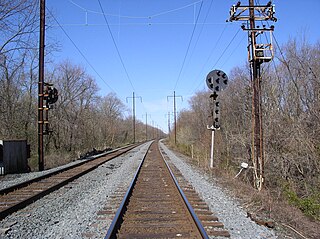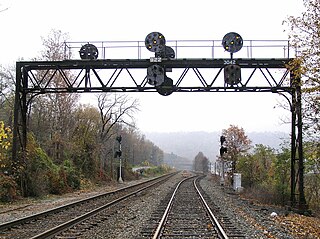Related Research Articles
The National Railway or National Air Line Railroad was a planned air-line railroad between New York City and Washington, D.C. in the United States around 1870. Part of it was eventually built from New York City to Philadelphia by the Delaware and Bound Brook Railroad and the Delaware River Branch of the North Pennsylvania Railroad, leased by the Philadelphia and Reading Railway, in 1879, and becoming its New York Branch. The line was intended to provide an alternate to the various monopolies that existed along the route, specifically the United New Jersey Railroad and Canal Companies and their Camden and Amboy Railroad, and as such had a long struggle to be built.
The Pittsburgh, Fort Wayne and Chicago Railway was a major part of the Pennsylvania Railroad system, extending the PRR west from Pittsburgh, Pennsylvania, via Fort Wayne, Indiana, to Chicago, Illinois. It included the current Norfolk Southern-owned Fort Wayne Line east of Crestline, Ohio, to Pittsburgh, and the Fort Wayne Secondary, owned by CSX, from Crestline west to Tolleston in Gary, Indiana. CSX leased its entire portion in 2004 to the Chicago, Fort Wayne and Eastern Railroad (CFE). The remaining portion of the line from Tolleston into Chicago is now part of the Norfolk Southern's Chicago District, with a small portion of the original PFW&C trackage abandoned in favor of the parallel lines of former competitors which are now part of the modern NS system.

The Pennsylvania Company was a major holding company. It included the Pittsburgh, Fort Wayne and Chicago Railway, the PRR's main route to Chicago. Together with the Pittsburgh, Cincinnati, Chicago and St. Louis Railroad and Vandalia Railroad, the three railroads were branded by the PRR as Pennsylvania Lines West of Pittsburgh. All lines west merged into the Pennsylvania Railroad in 1921.
The Keystone Subdivision is a railroad line owned and operated by CSX Transportation in the U.S. states of Maryland and Pennsylvania. The line runs from Cumberland, Maryland, west to McKeesport, Pennsylvania, along a former Baltimore and Ohio Railroad (B&O) line. The line includes the well-known Sand Patch Grade over the Allegheny Mountains.

The Harrisburg Subdivision is a railroad line owned by CSX Transportation in Pennsylvania. The line is located in Philadelphia, and connects Greenwich Yard and the Philadelphia Subdivision with the Trenton Subdivision along a former Pennsylvania Railroad line. Much of the Harrisburg Subdivision is the High Line' or West Philadelphia Elevated along 31st Street over the 30th Street Station area.

The Trenton Subdivision is a railroad line owned by CSX Transportation in the U.S. states of Pennsylvania and New Jersey. The line runs from CP NICE in Philadelphia, Pennsylvania, northeast to Port Reading Junction in Manville, New Jersey. The line was formerly part of the Reading Company system.

The P&W Subdivision is a railroad line owned and operated by CSX Transportation, the Allegheny Valley Railroad (AVR), and the Buffalo and Pittsburgh Railroad (BPRR) in the U.S. state of Pennsylvania. The line runs from Rankin north through Pittsburgh to West Pittsburg along a former Baltimore and Ohio Railroad line, once the Pittsburgh and Western Railroad.
The Southern Tier Line is a railroad line owned and operated by the Norfolk Southern Railway in the U.S. states of New York and Pennsylvania. The line was built by the Erie Railroad and its predecessors and runs from Buffalo, New York, to Suffern, New York. From its east end, NS has trackage rights south on the New Jersey Transit Main and Bergen County Lines to Conrail's North Jersey Shared Assets Area.

The Enola Branch is a rail line segment of the Port Road Branch and was a rail line. The Enola Branch rail line segment and the rest of the Port Road Branch is owned and operated by the Norfolk Southern Railway in the U.S. state of Pennsylvania. The rail line segment runs from Washington Boro northwest to Marysville and it is a former Pennsylvania Railroad rail line. Its south end is at a former junction with the Atglen and Susquehanna Branch, where the main segment of the Port Road Branch continues southeast. Its north end is at the Pittsburgh Line. Along the way, it meets the York Secondary at Wago Junction and goes under the Lurgan Branch at Lemoyne. Norfolk Southern labels the Enola Branch as part of the Port Road Branch, officially ending the Enola Branch's existence as a rail line. The main segment of the Port Road Branch runs from Marysville south to Perryville, Maryland. The line goes through the Enola Yard.

The Buffalo Line is a railroad line owned by the Norfolk Southern Railway in the U.S. states of New York and Pennsylvania. The line runs from Buffalo, New York southeast to Rockville, Pennsylvania near Harrisburg, Pennsylvania along a former Pennsylvania Railroad line. Its north end is at Seneca Yard in Buffalo, with no direct access to the Lake Erie district, and its south end is at the Pittsburgh Line at Rockville. The line is operated by the Buffalo and Pittsburgh Railroad between Buffalo and Machias, New York, the Western New York and Pennsylvania Railroad between Machias and Driftwood, Pennsylvania, and the Norfolk Southern Railway between Driftwood and Rockville.

The Sandusky District is a railroad line owned and operated by the Norfolk Southern Railway in the U.S. state of Ohio. The line runs from Columbus north to Sandusky along a former Pennsylvania Railroad line. At its south end, it junctions or comes close to the Columbus District, Dayton District, and West Virginia Secondary. On the way to the Chicago Line at Sandusky, it meets the Chicago Fort Wayne and Eastern Railroad at Bucyrus and the Fostoria District and Cleveland District at Bellevue.
The Lincoln Secondary is a railroad line owned and operated by Conrail in the U.S. state of Michigan as part of its Conrail Shared Assets Operations.
The Sunbury Line, formerly known as Sunbury Subdivision, is a rail line owned and operated by Norfolk Southern Railway which in turn is owned by the Norfolk Southern Corporation. The line travels from Sunbury, Pennsylvania, to Binghamton, New York, connecting with Norfolk Southern's Southern Tier Line at Binghamton and Norfolk Southern's Buffalo Line at Sunbury.
The Conemaugh Line is a rail line owned and operated by the Norfolk Southern Railway in the U.S. state of Pennsylvania. The line runs from Conpit Junction, Pennsylvania northwest and southwest to Pittsburgh, following the Conemaugh, Kiskiminetas, and Allegheny rivers, on the former main line of the Conemaugh Branch of the Pennsylvania Railroad (PRR). At its east end, it merges with the Pittsburgh Line; its west end is where it merges with the Fort Wayne Line at the northwestern tip of Allegheny Commons Park. The line was used by the PRR as a low-grade alternate to its main line, which is now part of Norfolk Southern's Pittsburgh Line, in the Pittsburgh area.
The Bedford Branch, previously the Bedford Division and then the Juniata Division, was a rail line owned and operated by the Pennsylvania Railroad, Middle Division in the U.S. state of Pennsylvania.

The Main Line of the Pennsylvania Railroad was a rail line in Pennsylvania connecting Philadelphia with Pittsburgh via Harrisburg. The rail line was split into two rail lines, and now all of its right-of-way is a cross-state corridor, composed of Amtrak's Philadelphia to Harrisburg Main Line and the Norfolk Southern Railway's Pittsburgh Line.

The Butler Branch was a historic railroad line that operated in Indiana, USA. It ran between the city of Logansport on the Wabash River in north central Indiana and the namesake town of Butler near the Ohio border in northeastern Indiana.
The Pittsburgh to St. Louis Main Line was a rail line owned and operated by the Pennsylvania Railroad in the U.S. states of Pennsylvania, Ohio, Indiana, and Illinois. The line ran from Pittsburgh, Pennsylvania west via Steubenville, Ohio, Columbus, Ohio, Dayton, Ohio, Indianapolis, Indiana, Terre Haute, Indiana, and Vandalia, Illinois to East St. Louis, Illinois. In addition to its east end in downtown Pittsburgh, where it met the Main Line and Pittsburgh to Chicago Main Line, junctions included the Columbus to Chicago Main Line at Columbus, the C&X Branch at Xenia, the Columbus to Indianapolis Main Line via Bradford at New Paris, the Richmond Branch and Fort Wayne Branch at Richmond, the Louisville Branch and I&F Branch at Indianapolis, and the Peoria Branch at Farrington, Illinois.
The Delaware Extension was a rail line owned and operated by the Pennsylvania Railroad in Philadelphia, Pennsylvania.
The South Side Railroad of Long Island was a railroad company in the U.S. state of New York. Chartered in 1860 and first opened in 1867 as a competitor to the Long Island Rail Road, it was reorganized in 1874 as the Southern Railroad of Long Island and leased in 1876 to the LIRR. After a reorganization as the Brooklyn and Montauk Railroad in 1879 it was merged in 1889.
References
- ↑ Pennsylvania Railroad, 1920s Division Accounting Maps
- 1 2 "PRR Corporate History: Pennsylvania Company". Archived from the original on 2002-01-11. Retrieved 2006-12-08.
- ↑ "PRR Chronology, 1873" (PDF). Archived from the original (PDF) on 2014-07-01. Retrieved 2006-12-08. (100 KiB), February 2005 Edition
- ↑ "PRR Chronology, 1874" (PDF). (95.9 KiB), March 2005 Edition
- ↑ PRR Corporate History: Western New York and Pennsylvania Archived 2001-06-01 at archive.today
- ↑ "PRR Chronology, 1900" (PDF). (59.2 KiB), March 2005 Edition
- ↑ "PRR Chronology, 1918" (PDF). (117 KiB), June 2004 Edition
- ↑ "PRR Chronology, 1931" (PDF). (68.9 KiB), August 2004 Edition
- ↑ "PRR Chronology, 1938" (PDF). (39.1 KiB), August 2004 Edition